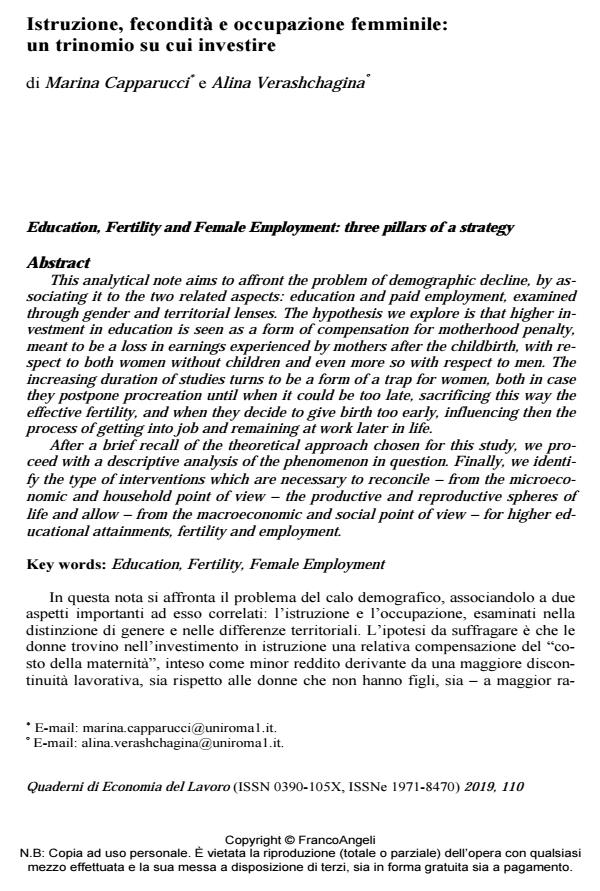Education, Fertility and Female Employment: three pillars of a strategy
Journal title QUADERNI DI ECONOMIA DEL LAVORO
Author/s Marina Capparucci, Alina Verashchagina
Publishing Year 2020 Issue 2019/110 Language Italian
Pages 20 P. 73-92 File size 469 KB
DOI 10.3280/QUA2019-110004
DOI is like a bar code for intellectual property: to have more infomation
click here
Below, you can see the article first page
If you want to buy this article in PDF format, you can do it, following the instructions to buy download credits

FrancoAngeli is member of Publishers International Linking Association, Inc (PILA), a not-for-profit association which run the CrossRef service enabling links to and from online scholarly content.
This analytical note aims to affront the problem of demographic decline, by associating it to the two related aspects: education and paid employment, exam-ined through gender and territorial lenses. The hypothesis we explore is that higher investment in education is seen as a form of compensation for motherhood penalty, meant to be a loss in earnings experienced by mothers after the child-birth, with respect to both women without children and even more so with respect to men. The increasing duration of studies turns to be a form of a trap for women, both in case they postpone procreation until when it could be too late, sacrificing this way the effective fertility, and when they decide to give birth too early, influ-encing then the process of getting into job and remaining at work later in life. After a brief recall of the theoretical approach chosen for this study, we pro-ceed with a descriptive analysis of the phenomenon in question. Finally, we iden-tify the type of interventions which are necessary to reconcile - from the microe-conomic and household point of view - the productive and reproductive spheres of life and allow - from the macroeconomic and social point of view - for higher educational attainments, fertility and employment.
Keywords: Education, Fertility, Female Employment
- Becker G.S. (1962). Investment in Human Capital: A Theoretical Analysis. Journal of Political Economy.
- Bettio F. e Villa P. (1998). A Mediterranean Perspective on the Break-Down of the Relationship between Participation and Fertility. Cambridge Journal of Economics.
- Blaug M. (1967). Economic Aspects of Vouchers for Education. In: Beales A., West E., Veale D., a cura di, Education: A Framework for Choice. London: Institute for Economic Affairs.
- Brucchi Luchino (2001). Manuale di Economia del lavoro. Bologna: il Mulino.
- Del Boca et al. (2012). Valorizzare le donne conviene. Bologna: il Mulino.
- Del Boca et. al. (2017). Parental and Child Time Investments and the Cognitive Development of Adolescents. Journal of Labor Economics, 35(2): 565-608.
- Del Bono et al. (2016). Early Maternal Time Investment and Early Child Outcomes. The Economic Journal, 126: F96-F135, ottobre.
- Fort M. et al. (2020). Cognitive and Noncognitive Costs of Day Care at Age 0-2 for Children in Advantaged Families. Journal of Political Economy, 128(1): 158-205.
- Franzini M. (2019). Dobbiamo preoccuparci della denatalità? E cosa possiamo fare?. Eticaeconomia, aprile.
- Frey L. (1979). Guida all’analisi economica dell’occupazione. Roma: Edizioni CERES.
- Ghignoni E. (2017). Family background and university dropouts during the crisis: the case of Italy. Higher Education 73: 127-151.
- ISTAT. (2019). Livelli di istruzione e ritorni occupazionali. Statistiche, Report, 15 luglio.
- McGinn K.L. et al. (2019). Learning From Mum: Cross-National Evidence Linking Maternal Employment and Adult Children’s Outcomes. Work, Employment and Society, 33(3): 374-400.
- Murgia A. e Poggio B., a cura di (2018). Saperi di genere. Prospettive interdisciplinari su formazione, università, lavoro, politiche e movimenti sociali. E-book.
- Smith A. (1776). Indagine sulla natura e le cause della ricchezza delle nazioni. Edizione italiana. Torino: UTET, pag. 711.
- Solow R. (1956). A Contribution to the Theory of Economic Growth. Quarterly Journal of Economics, 70(1): 65-94; Harrod R.F. (1948). Towards a dynamic economics e Domar E.D. (1957). Essays in the Theory of Economic Growth, i cui rispettivi lavori sono confluiti in una successiva rielaborazione di un modello più sinteticamente denominato di Harrod-Domar.
- Zimmerman K.F., a cura di (1989). Economic Theory of Optimal Population. Springer-Verlag Berlin Heidelberg.
Marina Capparucci, Alina Verashchagina, Istruzione, fecondità e occupazione femminile: un trinomio su cui investire in "QUADERNI DI ECONOMIA DEL LAVORO" 110/2019, pp 73-92, DOI: 10.3280/QUA2019-110004